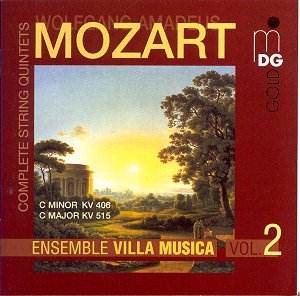This is the second volume in the Ensemble Villa Musica's
complete set of the Mozart string quintets, and these two works were
recorded in November 2000, immediately after the first and last of these
pieces (K174 and K614), which were issued as volume one earlier
this year.
The string quintets are perhaps Mozart's most significant
achievement in the field of chamber music, so any new recordings are
worthy of enthusiastic attention. The featured works here are the first
and the last of the series, date from 1787, although K496 is a little
problematic as far as its date of composition is concerned, being ascribed
too early a Köchel number. In any case this is a transcription
rather than an original composition, being an arrangement of the Wind
Serenade in C minor, K388. The music works well enough in its new format,
though in truth the subtleties are not as abundant as in the other mature
string quintets.
The quintet medium gave Mozart the opportunity to enrich
his chamber music thinking with the addition of an extra cello to the
foundation of the string quartet. Enrich is the right word too, for
he played the viola himself, and was often fond of using divided violas
in orchestral works, two tell-tale signs that the subtle addition found
in these quintets would bring special results.
The opening movement of the C major Quintet is a magnificent
inspiration, one of Mozart's greatest achievements in chamber music,
with an ideal balance between activity and poetry. The Ensemble Villa
Musica does the music proud, aided by a recording which is atmospheric
and full of presence. It really is of 'demonstration quality'. The quality
of the sound has a musical advantage, moreover, since the details in
the texture and the rich sonorities are heard to full advantage. The
remainder of this Quintet maintains these standards across a variety
of musical approaches, including a charming minuet and a lyrically inspired
slow movement.
The booklet contains detailed supporting information
and is nicely organised. In all this is a most attractive issue in what
is becoming an important chamber music collection.
Terry Barfoot

![]() Ensemble Villa Musica
Ensemble Villa Musica ![]() MDG 304 1032-2 [59.03]
MDG 304 1032-2 [59.03]